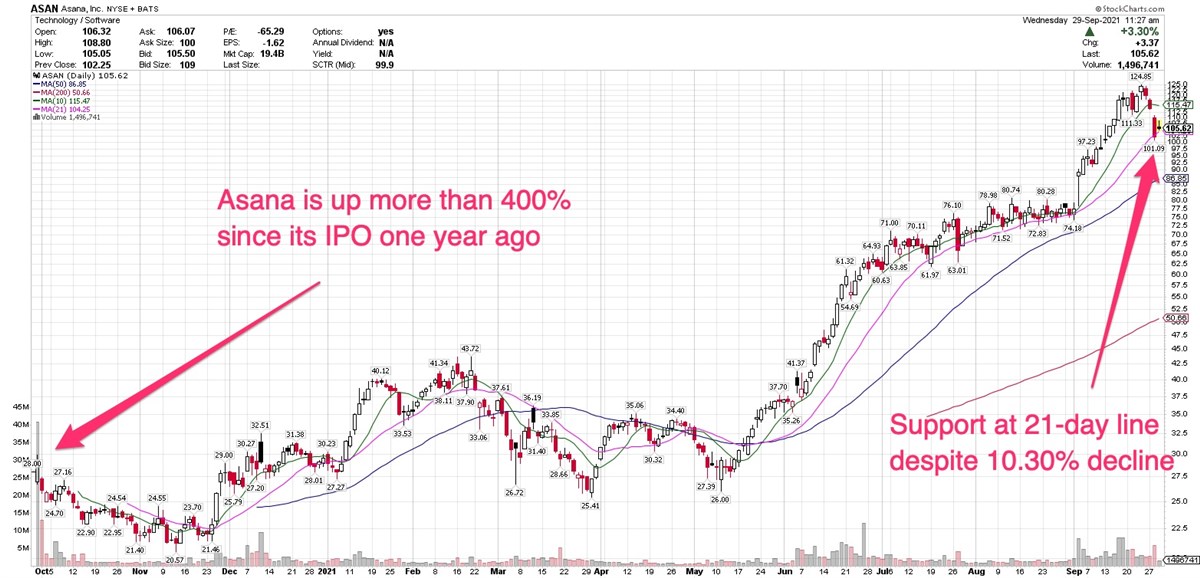One Year After IPO, Asana Shows Outstanding Price & Revenue Strength Cloud-based project management software Asana (NYSE: ASAN) celebrates one year as a public company on September 30. Since making its debut, priced at...
By Kate Stalter
This story originally appeared on MarketBeat

Cloud-based project management software Asana (NYSE: ASAN) celebrates one year as a public company on September 30. Since making its debut, priced at $21, shares are up more than 400%.
The stock tumbled along with the broader market Tuesday, dropping 10.30% to close at $102.25. Trading volume was 147% higher than normal, but that's not surprising on a day when the entire market was in a downward spiral, and techs, in particular, led equities lower.
Again, that underperformance of the sector is not a shock, given that tech has been the sector leading the market higher since last year. After a sustained rally, investors often choose to take some profits. Whether that's driven by algorithms or humans doesn't really matter; the effect is the same.
Asana rallied 32.12% in the past month, 66.48% in the past three months and 246.02% year-to-date.
Even in Tuesday's pullback, the stock found support at its 21-day moving average, a sign of continued confidence in the stock. Shares were rebounding Wednesday, along with a market-wide rally.
We're Not In Rally Mode Yet
As always, I caution investors not to become too giddy because a stock or the entire market rally after a sharp pullback. Remember, there are up days during a correction, and down days during a rally. One day does not a trend make.
Corrections, whether in a stock like Asana or in the broader market, are ultimately a good way to flush out excess and set the stage for institutional buyers to add shares at a lower price.
Asana's 50-day moving average is currently between $86 and $87. With shares finding support closer to the 21-day line near $103, it's a signal that institutions took some profits, but weren't in a mood to bail out en masse.
The revenue growth supports that decision.
In the past eight quarters, revenue grew at double-digit rates of 57% or higher. Growth accelerated in the past three quarters, coming in at $89.5 million most recently, a year-over-year gain of 72%.
In the past four quarters, Asana topped analysts' revenue expectations, according to MarketBeat data.
Meanwhile, despite reporting losses, which is very typical with young, fast-growing companies, Asana beat analysts' views. Losses were narrower than Wall Street expected.
This is a situation where a company has attracted institutional investment despite not reaching profitability yet. The number of mutual finds owning shares grew in each of the past three quarters, and stands at 251 as of the second quarter.
Drawing that type of institutional investment is not uncommon with high-potential growth stocks, and Asana is a poster child for that category. Its platform for work management is ideal for remote teams, which of course, are more common today than pre-pandemic.
Teams can collaborate on day-to-day tasks, marketing and sales campaigns and even streamline their processes.
Look For Industry Strength
These days, new companies offering digital work solutions are in high demand. For example, rival project/workflow management company Monday.com (NASDAQ: MNDY) has been on a tear since its June IPO. This stock, too, found support above its 50-day moving average in its recent pullback. Shares of Monday.com are up 41.90% in the past three months, despite a 7.70% pullback in the past month.
The company grew revenue at double- or triple-digit rates in the past six quarters.
Why does it matter what Monday.com is doing, if you are interested in Asana?
It's always a good sign if a stock's overall industry is showing strength. That's a sign that the company you're eyeing is part of a wider trend. Sure, it's absolutely possible to find an outlying stock that's performing well while its industry languishes, but growth stocks are typically part of a widespread uptrend.
According to MarketBeat data analysts have a "buy" rating on Asana, despite expecting a 37.45% downside, to $67.21.
That brings us to the question of: When should you buy this stock?
Right now, as it's consolidating, it's best to wait. As the broader market has bowed to selling pressure recently, it's not out of the question that more selling is ahead, regardless of Wednesday's bounce back.
Unless Asana begins to show significant price strength that's well ahead of the market, it's best to wait until the market goes back into rally mode. A wide rally tends to bring three-quarters of stocks higher along with it.









